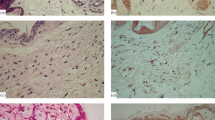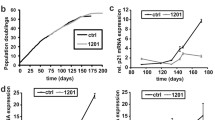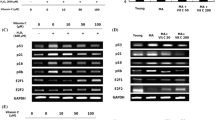Abstract
It has been shown recently that metformin, the indirect mTOR-kinase inhibitor, significantly increases medium (by 37.8 %) and maximum (by 10.3 %) life span of SHR mice (Anisimov et al., 2008). We obtained fibroblasts from skin of 11-, 16-, 19- and 23-months-old SHR mice treated with metformin since the third and ninth day of life. We studied markers of cellular senescence in these fibroblasts. Significant differences were observed between the average number of senescence-associated heterchromatic foci (SAHF), the average of area nuclei and fluorescence intensity of nucleus after staining for y-H2AX in control and experimental animals. Also, we showed that metformin prevented the accumulation of fibroblasts with large area of nuclei; high activity of senescence-associated P-galactosidase (SA-(3-gal), and high fluorescence intensity after staining for y-H2AX. It appears that accumulation of large quantity of senescence markers within a cell triggers it to enter the aging process. It appears that the increase of “old” cell population above the threshold disrupts the normal function of certain tissues, organs, and finally, the whole organism. It appears that metformin delays the “old” cells accumulation and prolongs the organism youth.
Similar content being viewed by others
Abbreviations
- mTOR:
-
mammalian target of rapamycin
- AMPK:
-
AMP-activated serinethreonine kinase
- SAHF:
-
senescence-associated heterochromatin foci
- SA-β-gal:
-
senescence-associated β-galactosidase
- IGF-1:
-
insulin-like growth factor-1
- γ-H2AX:
-
phosphorylated form of histone H2AX
- IF:
-
intensity of fluorescence
References
Anisimov, V.N., Molekulyarnye i fiziologicheskie mekhanizmy stareniya (Molecular and Physiological Mechanisms of Aging), St. Petersburg: Nauka, 2008a, vol. 2.
Anisimov, V.N., Berstein, L.M., Egormin, P.A., Piskunova, T.S., Popovich, I.G., Zabezhinski, M.A., Kovalenko, I.G., Poroshina, T.E., Semenchenko, A.V., Provinciali, M., Re, F., and Franceschi, C., Effect of Metformin on Life Span and on the Development of Spontaneous Mammary Tumors in HER-2/neu Transgenic Mice, Exp. Gerontol., 2005a, vol. 40, pp. 685–693.
Anisimov, V.N., Berstein, L.M., Egormin, P.A., Piskunova, T.S., Popovich, I.G., Zabezhinski, M.A., Tyndyk, M.L., Yurova, M.V., Kovalenko, I.G., Poroshina, T.E., and Semenchenko, A.V., Metformin Slows down Aging and Extends Life Span of Female SHR Mice, Cell Cycle, 2008, vol. 7, pp. 2769–2773.
Anisimov, V.N., Berstein, L.M., Popovich, I.G., Zabezhinski, M.A., Egormin, P.A., Tyndyk, M.L., Anikin, I.V., Semenchenko, A.V., and Yashin, A.I., Central and Peripheral Effects of Insulin/IGF-1 Signaling in Aging and Cancer: Antidiabetic Drugs as Geroprotectors and Anticarcinogens, Ann. N.Y. Acad. Sci., 2005b, vol. 1057, pp. 220–234.
Anisimov, V.N., Egormin, P.A., Piskunova, T.S., Popovich, I.G., Tyndyk, M.L., Yurova, M.V., Zabezhinski, M.A., Anikin, I,V., Karkach, A.S., and Romanyukha, A.A., Metformin Extends Life Span of HER-2/neu Transgenic Mice and in Combination with Melatonin Inhibits Growth of Transplantable Tumors in vivo, Cell Cycle, 2010a, vol. 9, pp. 188–197.
Anisimov, V.N., The Role of the Growth Hormone-Insulin-Like Growth Factor-1-Insulin System in Aging and Longevity: An Evolutionary Aspect, Ros. Fiziol. Zh. Im. I.M. Sechenova, 2008b, vol. 94, pp. 1092–1109.
Anisimov, V.N., Zabezhinski, M.A., Popovich, I.G., Piskunova, T.S., Semenchenko, A.V., Tyndyk, M.L., Yurova, M.V., Antoch, M.P., and Blagosklonny, M.V., Rapamycin Extends Maximal Life Span in Cancer-Prone Mice, Am. J. Pathol., 2010b, vol. 176, pp. 1092–2096.
Blagosklonny, M.V., Aging: ROS or TOR, Cell Cycle, 2008, vol. 7, pp. 3344–3354.
Campisi, J., Senescent Cells, Tumor Suppression, and Organismal Aging: Good Citizens, Bad Neighbors, Cell, 2005, vol. 120, pp. 513–522.
Chang, B.D., Watanabe, K., Broude, E.V., Fang, J., Poole, J.C., Kalinichenko, T.V., and Roninson, I.B., Effects of p21Waf1/Cip1/Sdi1 on Cellular Gene Expression: Implications for Carcinogenesis, Senescence, and Age-Related Diseases, Proc. Natl. Acad. Sci. USA, 2000, vol. 97, pp. 4291–4296.
Chen, Q.M., Bartolomew, J.C., Campisi, J., Acosta, M., Reagan, J.D., and Ames, B.N., Molecular Analysis of H2O2-Induced Senescent-Like Growth Arrest in Normal Human Fibroblasts: p53 an Rb Control G1 Arrest but not Cell Replication, J. Biochem., 1998, vol. 332, pp. 43–50.
Corradetti, M.N., Inoki, K., Bardeesy, N., DePinho, R.A., and Guan, K.L., Regulation of the TSC Pathway by LKB1: Evidence of a Molecular Link between Tuberous Sclerosis Complex and Peutz-Jeghers Syndrome, Genes Dev., 2004, vol. 18, pp. 1533–1538.
Demidenko, Z.N., Zubova, S.G., Bukreeva, E.I., Pospelov, V.A., and Blagosklonny, M.V., Rapamycin Decelerates Cellular Senescence, Cell Cycle, 2009, vol. 8, pp. 1888–1895.
Dimri, G.P., Lee, X., Basile, G., Acosta, M., Scott, G., Roskelley, C., Medrano, E.E., Linskensi, M., Rubeljii, I., Pereira-Smithii, O., Peacocke, M., and Campisi, J., A Biomarker That Identifies Senescent Human Cells in Culture and in Aging Skin in vivo, Proc. Natl. Acad. Sci. USA, 1995, vol. 92, pp. 9363–9367.
Everitt, A.V., Seedsman, N.J., and Jones, F., The Effects of Hypophysectomy and Continuous Food Restriction, Begun at Ages 70 and 400 Days, on Collagen Aging, Proteinuria, Incidence of Pathology and Longevity in the Male Rat, Mech. Ageing Dev., 1980, vol. 12, pp. 161–172.
Harrison, D.E., Strong, R., Sharp, Z.D., Nelson, J.F., Astle, C.M., Flurkey, K., Nadon, N.L., Wilkinson, J.E., Frenkel, K., Carter, C.S., Pahor, M., Javors, M.A., Fernandez, E., and Miller, R.A., Rapamycin Fed Late in Life Extends Lifespan in Genetically Heterogeneous Mice, Nature, 2009, vol. 460, pp. 392–395.
Inoki, K., Zhu, T., and Guan, K.L., TSC2 Mediates Cellular Energy Response to Control Cell Growth and Survival, Cell, 2003, vol. 115, pp. 577–590.
Itahana, K., Campisi, J., and Dimri, G.P., Methods to Detect Biomarkers of Cellular Senescence: the Senescence-Associated γ-Galactosidase, Methods Mol. Biol., 2007, vol. 371, pp. 21–32.
Jia, K., Chen, D., and Riddle, D.L., The TOR Pathway Interacts with the Insulin Signaling Pathway to Regulate C. elegans Larval Development, Metabolism and Life Span, Development, 2004, vol.. 131, pp. 3897–3906.
Kaeberlein, M., Powers, R.W. 3rd, Steffen, K.K., Westman, E.A., Hu, D., Dang, N., Kerr, E.O., Kirkland, K.T., Fields, S., and Kennedy, B.K., Regulation of Yeast Replicative Life Span by TOR and Sch9 in Response to Nutrients, Science, 2005, vol. 310, pp. 1193–1196.
Kapahi, P., Zid, B.M., Harper, T., Koslover, D., Sapin, V., and Benzer, S., Regulation of Lifespan in Drosophila by Modulation of Genes in the TOR Signaling Pathway, Curr. Biol., 2004, vol. 14, pp. 885–890.
Krtolica, A. and Campisi, J., Cancer and Aging: a Model for the Cancer Promoting Effects of the Aging Stroma, Int. J. Biochem. Cell Biol., 2002, vol. 34, pp. 1401–1414.
Lorenzini, A., Tresini, M., Austad, S.N., Cristofalo, V.J., Cellular Replicative Capacity Correlates Primarily with Species Body Mass not Longevity, Mech. Ageing Dev., 2005, vol. 126, pp. 1130–1133.
Medvedik, O., Lamming, D.W., Kim, K.D., and Sinclair, D.A., MSN2 and MSN4 Link Calorie Restriction and TOR to Sirtuin-Mediated Lifespan Extension in Saccharomyces cerevisiae, PLoS Biol., 2007, vol. 5, p. 261.
Michelson, V.M. and Gamaley, I.A., Shortening of Telomeres—The Basic Mechanism of Natural and Radiation-Induced Aging, Radiat. Biol. Radioecol., 2010, vol. 50, no. 3, pp. 269–275.
Michelson, V.M., Aging of Cell Cultures, in Biologiya kletki v kul’ture (The Biology of Cells in Culture), Leningrad: Nauka, 1984, pp. 235–255.
Mikhelson, V.M. and Gamaley, I.A., Telomere Shortening Is the Sole Mechanism of Aging, Open Longevity Sci., 2008, vol. 2, pp. 23–28.
Narita, M., Nũnez, S., Heard, E., Narita, M., Lin, A.W., Hearn, S.A., Spector, D.L., Hannon, G.J., and Lowe, S.W., Rb-Mediated Heterochromatin Formation and Silencing of E2F Target Genes during Cellular Senescence, Cell, 2003, vol. 113, pp. 703–716.
Powers, R.Wr., Kaeberlein, M., Caldwell, S.D., Kennedy, B.K., and Fields, S., Extension of Chronological Life Span in Yeast by Decreased TOR Pathway Signaling, Genes Dev., 2006, vol. 20, pp. 174–184.
Ryter, S.W., Kim, H.P., Hoetzel, A., Park, J.W., Nakahira, K., Wang, X., and Choi, A.M., Mechanisms of Cell Death in Oxidative Stress, Antioxid. Redox Signal., 2007, vol. 9, pp. 49–59.
Scaffidi, P. and Misteli, T., Lamin A-Dependent Nuclear Defects in Human Aging, Science, 2006, vol. 312, pp. 1059–1063.
Sharp, Z.D. and Bartke, A., Evidence for Downregulation of Phosphoinositide 3-Kinase/Akt/Mammalian Target of Rapamycin (PI3K/Akt/mTOR)-Dependent Translation Regulatory Signaling Pathways in Ames Dwarf Mice, J. Gerontol. A: Biol. Sci. Med. Sci., 2005, vol. 60, pp. 293–300.
Shaw, R.J., Bardeesy, N., Manning, B.D., Lopez, L., Kosmatka, M., DePinho, R.A., and Cantley, L.C., The LKB1 Tumor Suppressor Negatively Regulates mTOR sSignaling, Cancer Cell., 2004, vol. 6, pp. 91–99.
Shaw, R.J., LKB1 and AMP-Activated Protein Kinase Control of mTOR Signaling and Growth, Acta Physiol., 2009, vol. 196, pp. 65–80.
Shelton, D.N., Chang, E., Whittier, P.S., Choi, D., and Funk, W.D., Microarray Analysis of Replicative Senescence, Curr. Biol., 1999, vol. 9, pp. 939–945.
Sonntag, W.E., Lynch, C.D., Cefalu, W.T., Ingram, R.L., Bennett, S.A., Thornton, P.L., and Khan, A.S., Pleiotropic Effects of Growth Hormone and Insulin-Like Growth Factor (IGF)-1 on Biological Aging: Inferences from Moderate Caloric-Restricted Animals, J. Gerontol. A: Biol. Sci. Med. Sci., 1999, vol. 54, pp. B521–538.
Spindler, S.R., Caloric Restriction: From Soup to Nuts, Ageing Res. Rev., 2010, vol. 9, pp. 324–353.
Spindler, S.R., Use of Microarray Biomarkers to Identify Longevity Therapeutics, Aging Cell., 2006, vol. 5, pp. 39–50.
Vellai, T., Takacs-Vellai, K., Zhang, Y., Kovacs, A. L., Orosz, L., and Muller, F., Genetics: Influence of TOR Kinase on Lifespan in C. elegans, Nature, 2003, vol. 426, pp. 620.
Zhang, H., Pan, K.H., and Cohen, S.N., Senescence-Specific Gene Expression Fingerprints Reveal Cell-Type-Dependent Physical Clustering of up-Regulated Chromosomal Loci, Proc. Natl. Acad. Sci. USA, 2003, vol. 100, pp. 3251–3256.
Author information
Authors and Affiliations
Corresponding author
Additional information
Original Russian Text © A.V. Arkadieva, A.A. Mamonov, I.G. Popovich, V.N. Anisimov, V.M. Mikhelson, I.M. Spivak, 2011, published in Tsitologiya, Vol. 53, No. 2, 2011, pp. 166–174.
Rights and permissions
About this article
Cite this article
Arkadieva, A.V., Mamonov, A.A., Popovich, I.G. et al. Metformin slows down ageing processes at the cellular level in SHR mice. Cell Tiss. Biol. 5, 151–159 (2011). https://doi.org/10.1134/S1990519X11020027
Received:
Published:
Issue Date:
DOI: https://doi.org/10.1134/S1990519X11020027




